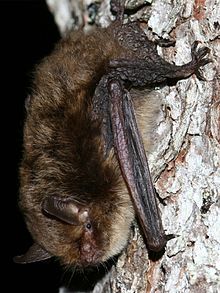Myotis alcathoe
| Myotis alcathoe | |
|---|---|
 |
|
| Scientific classification | |
| Kingdom: | Animalia |
| Phylum: | Chordata |
| Class: | Mammalia |
| Order: | Chiroptera |
| Family: | Vespertilionidae |
| Genus: | Myotis |
| Species: | M. alcathoe |
| Binomial name | |
|
Myotis alcathoe von Helversen and Heller, 2001 |
|
 |
|
| Some of the localities where M. alcathoe has been recorded (red) and possible records (green) | |
The Alcathoe bat (Myotis alcathoe) is a European bat in the genus Myotis. Known only from Greece and Hungary when it was first described in 2001, its known distribution has since expanded to Spain, England, Sweden, and Azerbaijan, among other countries. It is similar to the whiskered bat (Myotis mystacinus) and other species and is difficult to distinguish from them. However, its brown fur is distinctive and it is clearly different in characters of its karyotype and DNA sequences. Although some genetic data suggest that it is related to Geoffroy's bat (Myotis emarginatus), other analyses do not support a close relationship between M. alcathoe and any other species.
With a forearm length of 30.8 to 34.6 mm (1.21 to 1.36 in) and body mass of 3.5 to 5.5 g (0.12 to 0.19 oz), Myotis alcathoe is a small bat. The fur is usually reddish-brown on the upperparts and brown below, but more grayish in juveniles. The tragus (a projection on the inner side of the ear) is short, as is the ear itself, and the inner side of the ear is pale at the base. The wings are brown and the baculum (penis bone) is short and broad. M. alcathoe has a very high-pitched echolocation call, with a frequency that falls from 120 kHz at the beginning of the call to about 43 kHz at the end.
Usually found in old-growth deciduous forest near water, Myotis alcathoe forages high in the canopy and above water and mostly eats flies. The animal roosts in cavities high in trees. Although there are some winter records from caves, it may also spend the winter in tree cavities. Several parasites have been recorded on M. alcathoe. The IUCN Red List assesses Myotis alcathoe as "data deficient", but it is considered threatened in several areas because of its rarity and vulnerability to habitat loss.
...
Wikipedia

